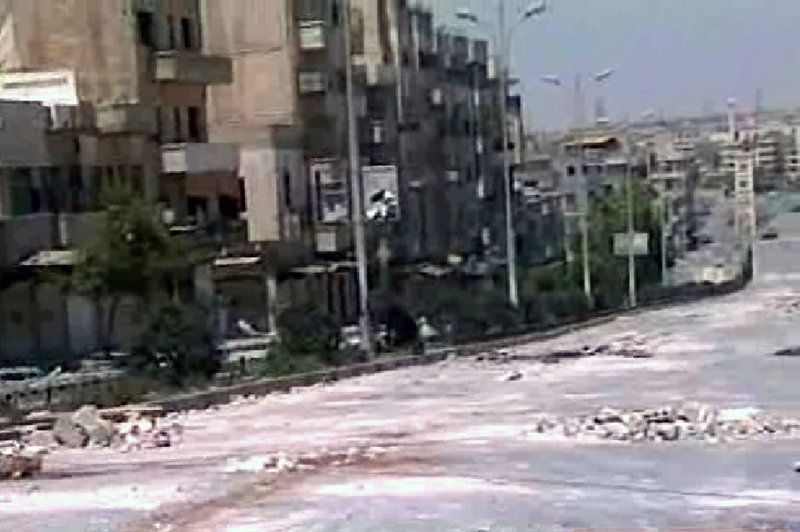BEIRUT – Syria’s government showed off TV and still images of burned buildings and rubble-strewn streets empty of people in Hama, the epicenter of anti-regime protests, and claimed Friday it was putting an end to the rebellion in the besieged city.
Under the suffocating clampdown, residents of the city warned that medical supplies were running out and food was rotting after six days without electricity.
Across the country, tens of thousands of protesters marched, chanting their solidarity with Hama and demanding the ouster of President Bashar Assad. They were met by security forces who opened fire, killing at least 13 people, activists said.
Government forces began their ferocious assault on Hama Sunday, cutting off electricity, phone services and Internet and blocking supplies into the city of 800,000 as they shelled neighborhoods and sent in tanks and ground raids.
It appeared to be an all-out attempt to take back the city — which has a history of dissent — after residents all but took it over since June, barricading it against the regime. Rights group say at least 100 people have been killed, while some estimates put the number as high as 250.
The tolls could not be verified because of the difficulty reaching residents and hospital officials in the city, where journalists are barred as they are throughout Syria.
Tanks shelled residential districts of Hama starting around 4 a.m. Friday, just as people were beginning their daily fast for the Muslim holy month of Ramadan — mirroring a bombardment the evening before at sunset, when people were breaking the fast, one resident told The Associated Press.
“If people get wounded, it is almost impossible to take them to hospital,” the resident said by telephone.
Syrian state media on Friday proclaimed army units were “working to restore security, stability and normal life to Hama,” which it said had been taken over by “terrorists.” The message mirrored the regime’s claim that armed extremists seeking to destabilize the country are behind the unrest, as opposed to true reform-seekers.
For the first time since the siege began, government-run TV and the state news agency aired images of the ravaged streets of Hama, strewn with debris, damaged vehicles and makeshift barricades. In one, a yellow taxi was shown with a dead man in the driver’s seat and bloodstains on the door. A tank cleared away a large cement barrier and a bus with shattered windows.
There were no reports of protests in the city during the day Friday — a contrast to previous weeks when hundreds of thousands participated in the biggest marches in the country.
A citizen journalist from Hama working with an online global activist group, Avaaz, told AP that people were now too afraid to go to the mosques, which were being targeted by the military.
The man, who identified himself as Sami, described the humanitarian situation as “catastrophic.” Everything was closed, including bakeries and pharmacies, he said. “You cannot imagine how tired and terrified people are.”
Hama has seen government crackdowns before. In 1982, Assad’s father, Hafez Assad, ordered the military to quell a rebellion by Syrian members of the conservative Muslim Brotherhood movement there, sealing off the city in an assault that killed between 10,000 and 25,000 people.
Send questions/comments to the editors.



Success. Please wait for the page to reload. If the page does not reload within 5 seconds, please refresh the page.
Enter your email and password to access comments.
Hi, to comment on stories you must . This profile is in addition to your subscription and website login.
Already have a commenting profile? .
Invalid username/password.
Please check your email to confirm and complete your registration.
Only subscribers are eligible to post comments. Please subscribe or login first for digital access. Here’s why.
Use the form below to reset your password. When you've submitted your account email, we will send an email with a reset code.